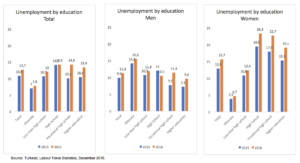In Turkey, female participation in the labor force is extremely poor by international standards. The highest rate of female workers in the service sector was seen in 2018, with 56.1 percent. The statistics showed that the more women engaged in the labor force, the higher the level of education. 72.7 percent for women who graduated from universities in the workforce in 2018, while this figure falls to 27.7 percent for those whose level of education was below the secondary school level. “In its “Women in Statistics 2018” report released on Wednesday, TUIK determined that the women above the age of 15 in the labor force is 28.9 percent while it was 65.6 percent for men” (Europe, 2019). Over the past decade, policies introduced have compensated women to take care of their children or give them longer unpaid leave. These policies, however, have done little to relieve women of unpaid job duties that prohibit them from collecting cash to help their families. Authorities have also failed to enact legislation requiring businesses to provide on-site child care to allow more women to return to work after birth. “A woman who refuses maternity and gives up housekeeping … is a half [person]” (TheWorld, 2017). According to the World Bank, introducing one year of preschool education in Turkey could increase women’s participation in the labor force by 9 percent, and gender diversity in jobs could increase per capita income by 22 percent. As a result, in Turkey, only one in three women is participating in the labor force.
In Turkey, according to the World Bank’s compilation of development indicators, collected from officially recognized sources, the labor force participation rate, male (percentage of male population aged 15 +) (model ILO estimate) in Turkey was registered at 72.41 percent in 2020. As of October 2020, real values, historical data, forecasts, and estimates were collected from the World Bank. “The labor force participation rate of men has been decreasing since the 1950s, having registered 86.4 percent in 1950, 79.7 percent in 1970, 76.4 percent in 1990, and 73.3 percent in 2005. This decline has resulted from various factors” (U.S. Bureau of Labor Statistics, 2012). The Social Security Act, for instance, was revised in 1960 to allow disability benefits available for people under 50 years of age. The decrease in the participation rate of the men’s labor force is expected to continue; it is estimated to be 70 percent in 2020 and 66 percent in 2050.
As shown in fig. 4 the chart below, unemployment by education total, unemployment by education men, unemployment by education women.




